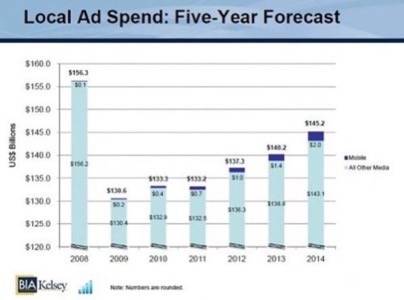When it rains, it pours! Today, there’s a ton of new information about mobile advertising trends and new initiatives, all of which should catch the eye of marketers, advertisers and developers alike.

For starters, a new report from Millennial Media finds Android ad requests are on the rise. Meanwhile, IDC notes that Apple’s iAd program is now closing in on Google’s mobile sales, and this year we may end up seeing the two companies tied for market share. Also, Blackberry smartphone maker RIM has just announced its own ad solution called Blackberry Advertising Service and it looks appealing. As for location-based ads, there’s good news here too: local ad revenues are expected to grow to $2 billion by 2014.
Mobile Ads: Sorry, But You Have to Care About This
Whether you’re looking to capitalize on the mobile platform for selling your product or service to end users or you’re a mobile application developer trying to effectively monetize your latest creation, you can’t turn a blind eye to what’s happening in the mobile advertising industry today.
And just like everything in the mobile ecosystem, the changes come fast and can be hard to follow.
Here’s what you need to know now to stay on top of the latest trends:
1. Android Ad Requests Way, Way Up
Since January of this year, Android ad requests have increased by 996% and are increasing at rate of 39% month-over-month, according to Millennial Media, which maintains the largest ad network in the U.S, reaching 80% of the mobile audience. Android is now the second-largest platform on the network with a 26% share of smartphone OS ad impressions. Apple is still number one, with a 29% share.
Key Takeaway: There’s rapid iPhone and Android growth going on now and impressions are coming from a diverse set of carriers and device types, including smartphones, feature phones and connected devices. Android is clearly growing fast.
Read more here on Millennial Media’s site.
2. iAd is Doing Well
Research firm IDC is predicting that Apple’s iAd mobile advertising platform will compete head-to-head with Google in terms of ad sales by the end of 2010. According to Business Week, IDC predicts Apple will end up with 21% of the market by year-end and Google will drop to 21% from its 27% share measured last year at the same time. This includes the results from Google’s acquisition of Ad Mob, the network it bought in May. Microsoft is predicted to drop from 10% to 7%.
Key Takeaway: Although this report seems to counter the trend of Android’s rise in ad impressions mentioned above, it actually doesn’t. Millennial Media’s report is tracking trends in mobile ad requests, not overall market share. Android’s ad requests are up, but in market share even Millennial sees the two companies with similar portions of the overall market (26% for Android, 29% for Apple). Apple and Google are nearly neck-and-neck.
Read more here on Business Week and TechRadar.
3. Don’t Count Out RIM: New Blackberry Advertising Service Should Appeal to Devs
If you’re targeting the corporate user, RIM’s new offering may have some appeal. Hoping it’s “better late than never,” RIM has announced its new mobile ad solution called the BlackBerry Advertising Service. The service’s aim is to help app developers monetize their products.
With “just a few lines of code,” developers can include ads in their apps which are relevant and tie into the core Blackberry smartphone features including Contacts, Calendar, the Media Player and BlackBerry App World, the company’s App Store offering. The service includes three main features: an SDK (software development kit), a mediation platform where developers manage the ads and track analytics and a “growing slate” of advertising networks, says RIM. For now that slate includes Amobee, Jumptap, Lat49, Millennial Media and Mojiva but RIM says Buzzcity, NavTeq, Placecast, Sympatico, Transpera, Where, xAD, and Medialets are expected to come on board in the future.
Key Takeaway: RIM is offering not just monetization but analytics too, a combination which should be attractive to its developer community. The company still has a sizable audience (50 million customers) despite recent market share losses to Android. But some analysts are still worried how RIM’s offering will fare in the larger mobile ad market.
Read the press release and ABI’s take.
4. Local Ads are a Hot Trend
Location-based fill-in-the-blank-here is one of the hottest trends in the tech industry today and the mobile local ad market is no exception. New data from BIA/Kelsey details the size and growth opportunities in the local advertising market and is forecasting the market will reach $2.02 billion by 2014. For comparison purposes, it was $213 million last year.
In this case, BIA/Kelsey is defining a local mobile ad as one that’s “targeted based on a user’s location as is actionable on a local basis,” reports mobile site MocoNews.

Key Takeaway: There’s big money in local ads but they’re still going to remain a miniscule portion of the overall local media market. In 2009, local mobile ads accounted for 0.2% of local media and by 2014 that will only increase to 1.4%.
Read more here on MocoNews or visit the KelseyGroup’s site.
5. Outside U.S., Nokia Leads in Ad Requests, but Smartphones Dominate
An interesting report from ADITIC, a mobile ad network from Sofialys, gives a glimpse into the non-U.S. mobile advertising world. According to mobile site GoMoNews, Sofialys’ audience is primarily Europe, Africa and Asia which gives it the advantage of seeing trends occurring outside the United States, a market which tends to dominate most mobile ad reports and analysis these days.
Here, ADITIC found that Nokia devices generate the most ad requests (29%). iPhone gets 21% then Samsung and LG are at 13% and 6% respectively. However, iPhones and Android dominate the traffic ADITIC sees.
Key Takeaway: Smartphones are best for display ads but remember that feature phone users can see ads too.
Read more here on GoMoNews.
Image credits: Fonehome.co.uk & Kelsey Group









